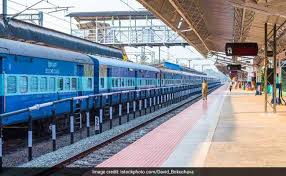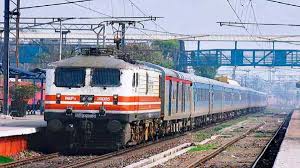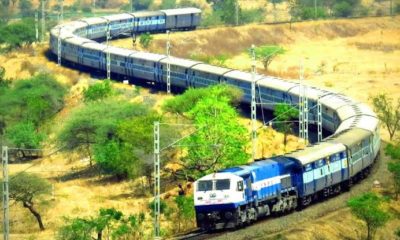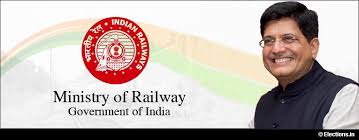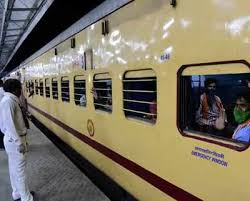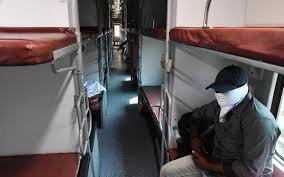Feature
Train 18 pelted with stones during trial run by Indian Railways

New Delhi: The Railways’ fastest train – Train 18, which is scheduled to be flagged off by Prime Minister Narendra Modi on December 29, was pelted with stones on Thursday during a trial run between Delhi and Agra, a senior official said.

“Train 18 running at 180 km/h between Delhi and Agra at this time… Srinivas, the Chief Design Engineer of ICF is in the cab, they touched 181 kmh for record sake… Some vandal threw a stone breaking a glass, hope we nab him,” tweeted Sudhanshu Manu, General Manager of the Integral Coach Factory that manufactured these state-of-the-art rakes.
The incident is being investigated, officials said. The country’s first engineless train will replace Shatabdi trains and will run between Delhi and Varanasi.

Train 18, manufactured by ICF Chennai at a cost of Rs 100 crore, recently became India’s fastest train by hitting speeds of over 180 kmph during a trial run on a section of the Delhi-Rajdhani route.
Stone pelted at India’s first engineless Train 18 during trail run:

The gleaming blue-nosed train comes fitted with amenities at par with the best in the world — from on-board WiFi to a GPS-based passenger information system, touch-free bio-vacuum toilets, LED lighting, mobile charging points and a climate control system that adjusts the temperature according to occupancy and weather.
The train will have two executive compartments which will have 52 seats each and trailer coaches will have 78 seats each. The executive class will have rotating seats to match the direction of the train.

According to the tentative plan, the train will start from New Delhi station at 6 am and is expected to reach Varanasi at 2 pm. For the return journey, the train will start at 2.30 pm from Varanasi and reach the national capital at 10.30 pm on the same day.
Railway Minister Piyush Goyal, impressed with the success of Train 18 during trials, has recently asked ICF to build four more similar rakes in the current financial year.
Entertainment
Meghalaya Reserves Legalized Gambling and Sports Betting for Tourists

The State Scores Extra High on Gaming-Friendly Industry Index
Meghalaya scored 92.85 out of 100 possible points in a Gaming Industry Index and proved to be India’s most gaming-friendly state following its recent profound legislation changes over the field allowing land-based and online gaming, including games of chance, under a licensing regime.
The index by the UK India Business Council (UKIBC) uses a scale of 0 to 100 to measure the level of legalisation on gambling and betting achieved by a state based on the scores over a set of seven different games – lottery, horse racing, betting on sports, poker, rummy, casino and fantasy sports
Starting from February last year, Meghalaya became the third state in India’s northeast to legalise gambling and betting after Sikkim and Nagaland. After consultations with the UKIBC, the state proceeded with the adoption of the Meghalaya Regulation of Gaming Act, 2021 and the nullification of the Meghalaya Prevention of Gambling Act, 1970. Subsequently in December, the Meghalaya Regulation of Gaming Rules, 2021 were notified and came into force.
All for the Tourists
The move to legalise and license various forms of offline and online betting and gambling in Meghalaya is aimed at boosting tourism and creating jobs, and altogether raising taxation revenues for the northeastern state. At the same time, the opportunities to bet and gamble legally will be reserved only for tourists and visitors.
“We came out with a Gaming Act and subsequently framed the Regulation of Gaming Rules, 2021. The government will accordingly issue licenses to operate games of skill and chance, both online and offline,” said James P. K. Sangma, Meghalaya State Law and Taxation Minister speaking in the capital city of Shillong. “But the legalized gambling and gaming will only be for tourists and not residents of Meghalaya,” he continued.
To be allowed to play, tourists and people visiting the state for work or business purposes will have to prove their non-resident status by presenting appropriate documents, in a process similar to a bank KYC (Know Your Customer) procedure.
Meghalaya Reaches Out to a Vast Market
With 140 millions of people in India estimated to bet regularly on sports, and a total of 370 million desi bettors around prominent sporting events, as per data from one of the latest reports by Esse N Videri, Meghalaya is set to reach out and take a piece of a vast market.
Estimates on the financial value of India’s sports betting market, combined across all types of offline channels and online sports and cricket predictions and betting platforms, speak about amounts between $130 and $150 billion (roughly between ₹9.7 and ₹11.5 lakh crore).
Andhra Pradesh, Telangana and Delhi are shown to deliver the highest number of bettors and Meghalaya can count on substantial tourists flow from their betting circles. The sports betting communities of Karnataka, Maharashtra, Uttar Pradesh and Haryana are also not to be underestimated.
Among the sports, cricket is most popular, registering 68 percent of the total bet count analyzed by Esse N Videri. Football takes second position with 11 percent of the bets, followed by betting on FIFA at 7 percent and on eCricket at 5 percent. The last position in the Top 5 of popular sports for betting in India is taken by tennis with 3 percent of the bet count.
Local Citizens will Still have Their Teer Betting
Meghalaya residents will still be permitted to participate in teer betting over arrow-shooting results. Teer is a traditional method of gambling, somewhat similar to a lottery draw, and held under the rules of the Meghalaya Regulation of the Game of Arrow Shooting and the Sale of Teer Tickets Act, 2018.
Teer includes bettors wagering on the number of arrows that reach the target which is placed about 50 meters away from a team of 20 archers positioned in a semicircle.
The archers shoot volleys of arrows at the target for ten minutes, and players place their bets choosing a number between 0 and 99 trying to guess the last two digits of the number of arrows that successfully pierce the target.
If, for example, the number of hits is 256, anyone who has bet on 56 wins an amount eight times bigger than their wager.


















